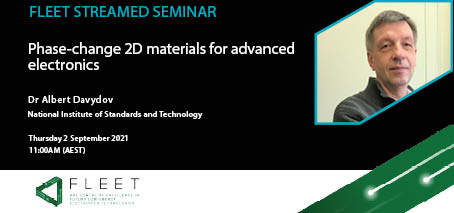-
2 Sep 2021
11:00 am - 12:00 pm
Albert Davydov, Material Science and Engineering Division
National Institute of Standards and Technology, Gaithersburg, MD USA
Meeting ID: 876 1237 0573 / Passcode: 12345
Layered van-der-Waals 2D materials, including transition metal dichalcogenides (TMD), enable a broad range of advanced electronic applications. The ability to manipulate electrical and optical properties by externally stimulated structural phase transitions in TMD materials opens a possibility for fabricating energy-efficient non-volatile memories and transport devices. In this seminar, I will discuss controlled growth and reversible phase transitions in molybdenum ditelluride single crystals targeting the above applications.
MoTe2 crystallizes in the following three polytypes:
- 2H semiconducting phase, thermodynamically stable at room temperature
- 1T’ metallic phase, stable above 870 °C
- Td topological semimetal, stable below -25 °
We have grown 2H and 1T’ bulk single crystals by chemical vapor transport and studied dynamics of temperature-induced 2H « 1T’ phase transition using STEM, XRD, XPS and Raman. In addition, we manipulated the 2H-to-1T’ transition temperature by substituting Mo with W in Mo1-xWxTe2 alloys. Noteworthy, spreading alloys composition to pure WTe2 opens a possibility to elevate the 1T’ « 1Td transition temperature from topologically trivial 1T’ to type-II Weyl Td phase to above room temperature.
The experimental knowledge about relationship between 2H, 1T’ and Td polytypes was mapped on the MoTe2 – WTe2 phase diagram and allowed us and our collaborators to fabricate RRAM [1], lateral homojunction FET [2] an orbital photogalvanic detector [3] devices.
Albert Davydov is a leader of Functional Nanostructured Materials Group at NIST that focuses on materials and processes for advanced electronics, magnetics, energy, and catalysis. He received his PhD in Chemistry from Moscow State University (Russia) and will be celebrating his 25-year career at NIST in 2022. His research interests include fabrication, processing, and microstructural characterization of a wide range of electronic materials including semiconductor nanowires, 2D and quantum materials. His expertise also includes thermodynamic modeling and experimental study of phase diagrams for metal and semiconductor material systems.
He is a member of the following: the Technical Committee 229 (Nanotechnology) at the International Organization for Standardization (ISO); the Science Advisory Board with the nanoelectronics Computing Research (nCORE) program at Semiconductor Research Corporation (SRC); and the Advisory Board of Applied Physics Review journal. He also serves as a Head of the Semiconductor Task Group for the International Centre for Diffraction Data (ICDD), co-Chair of the Reference Materials Task Group at ASTM Subcommittee on Compound Semiconductors, and co-Chair of SPIE Optics & Photonics Conference on Low-dimensional Materials and Devices.
References:
- F. Zhang et al., Electric-field induced structural transition in vertical MoTe2 and Mo1-xWxTe2-based resistive memories, Nature Materials 18 (2019) 55
- R.Ma et al., MoTe2 Lateral Homojunction Field-Effect Transistors Fabricated using Flux-Controlled Phase Engineering, ACS Nano 13 (2019) 8035
- Z. Ji et al., Photocurrent detection of the orbital angular momentum of light, Science 368 (2020) 763
Time converter at worldtimebuddy.com

